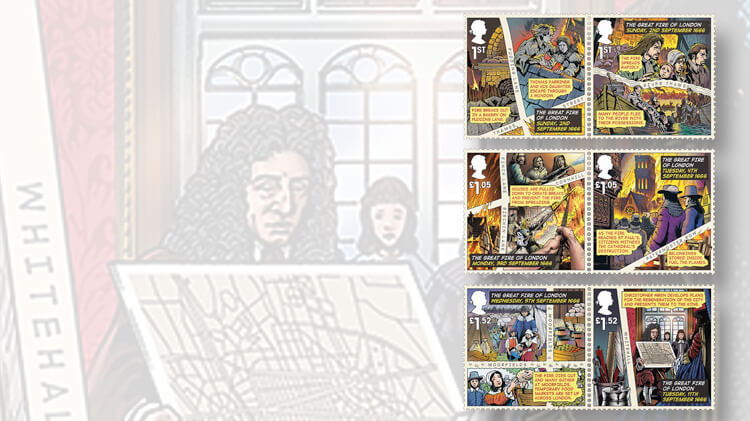World Stamps
New British stamps portray Great Fire of London using graphic-novel style

By Denise McCarty
Six new stamps from Great Britain’s Royal Mail illustrate the start, spread, and end of the Great Fire of London. The stamps were issued Sept. 2 to commemorate the 350th anniversary of this catastrophe.
Royal Mail said: “In the early hours of Sunday 2 Sept. 1666 a fire breaks out in bakery of Thomas Farriner in Pudding Lane, London. Over the next few days the fire spreads through the city, the close-packed wooden houses, with thatch, stored materials like pitch and tar plus strong westerly wind making a ‘perfect storm.’ ”
The stamp designs are in a “graphic novel style,” according to Royal Mail. In general, graphic novels use comic-book style art and text to tell a story.
Connect with Linn’s Stamp News:
Sign up for our newsletter
Like us on Facebook
Follow us on Twitter
Comic book artist John Higgins created the illustrations for the stamps. They were printed in se-tenant (side-by-side) pairs.
Higgins, whose other works include Judge Dredd, 2000 AD and Watchmen, said: “It is an honour to illustrate these stamps and to commemorate this moment in history 350 years on. Capturing the story of the Great Fire of London in just six Special Stamps was a wonderful challenge, I am thrilled to have been chosen to bring the graphic-novel style to Royal Mail’s Special Stamps for the first time.”
This illustrated story of the 1666 fire that destroyed approximately 80 percent of London and left 100,000 people homeless begins on the pair of nondenominated first-class stamps. The stamp on the left shows the start of the fire around 2 a.m. Sunday, Sept. 2, in Farriner’s bakery, including a scene of Farriner and his daughter escaping through a window.
The images are separated by a drawing of the intersection of Pudding Lane and Thames Street. A similar street-map technique is used on all of the designs.
The other first-class stamp depicts the rapid spreading of the fire and people fleeing to the River Thames with their possessions.
Diarist Samuel Pepys (1633-1703) described the scene: “Everybody endeavoring to remove their goods, and flinging into the river or bringing them into lighters that lay off; poor people staying in their houses as long as till the very fire touched them, and then running into boats, or clambering from one pair of stairs by the water-side to another.”
The two £1.05 stamps show the spread of the fire on Sept. 3-4 and efforts made to stop it. On the left-hand stamp, houses are being pulled down to create firebreaks, and three men are using a fire squirt.
The Museum of London website describes this equipment: “Made of brass, this squirt is like a very large syringe. The nozzle is dipped into a bucket of water and the rod is pulled out, sucking the water up. At least two people are needed to use it: one to hold the handles on each side and another to push the rod in, squirting the water out into the fire.”
On the other £1.05 stamp, the fire has reached Paternaster Row on Sept. 4, and a crowd watches as the flames engulf St. Paul’s Cathedral, one of more than 80 churches destroyed by the fire.
During the night on Sept. 4, the wind dropped, helping those fighting the blaze. By the morning of Sept. 6, the fire was extinguished, though some areas of London smouldered for another few months.
The aftermath of the fire is illustrated on the £1.52 pair.
The first of the two stamps shows the homeless camping in tents at Moorfields on Sept. 5. Temporary food markets that have been set up around the city also are pictured.
The final stamp depicts a scene almost a week later, on Sept. 11, when architect Christopher Wren presented his plan for rebuilding London to King Charles II. John Evelyn and Robert Hooke later presented plans as well.
The Chase designed the stamps, using the illustrations by Higgins. International Security Printers printed them by offset in sheets of 60 (sold in panes of 30 at most postal outlets). The stamps are square, 35 millimeters by 35mm, and are perforated gauge 14.5 by 14.5.
The current first-class rate is 64 pence. The stamps denominated £1.05 pay the rate for mail to Europe up to 20 grams and to international countries up to 10 grams, and the £1.52 stamps pay the rate for mail to Europe weighing mail up to 100 grams.
Royal Mail’s other products for the Great Fire of London set include first-day covers; a presentation pack with illustrations by graphic-novel artist Leigh Gallagher; and six postcards reproducing the designs of the stamps.
Ordering information is available from Royal Mail, Tallents House, 21 S. Gyle Crescent, Edinburgh, EH12 9PB, Scotland.
Royal Mail’s two agencies in the United States are Interpost, Box 420, Hewlett, NY 11557; and the British Stamp Service in North America, 1 Unicover Center, Cheyenne, WY 82008.
MORE RELATED ARTICLES
Headlines
-
US Stamps
Oct 7, 2024, 3 PMMcMurtrie dismissed as APS education director following Sept. 21 arrest
-
US Stamps
Oct 7, 2024, 12 PMVasiliauskas named president of Mystic Stamp Co.
-
US Stamps
Oct 6, 2024, 5 PMApgar souvenir card available
-
US Stamps
Oct 6, 2024, 4 PMFirst Continental Congress and U.N. stamps receive Scott catalog numbers








